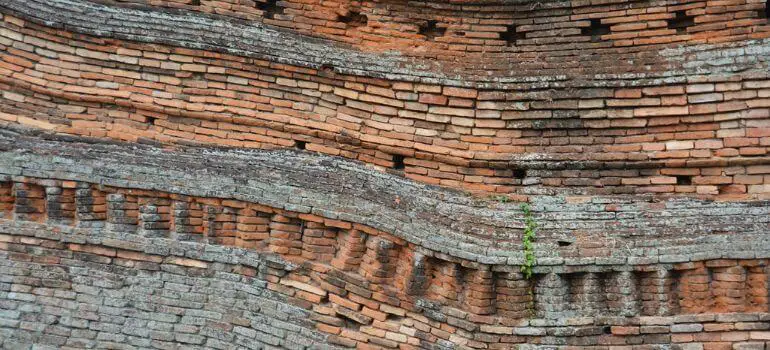Introduction to Wall Straightening
Straight lines are essential in construction and interior design, providing aesthetic appeal and structural integrity. However, dealing with crooked walls can be a common yet challenging issue for homeowners and builders alike.
Understanding Wall Irregularities
Crooked walls can result from various factors, including foundational shifts, poor construction, or natural wear and tear. Understanding these irregularities is crucial for effective correction.
Tools and Materials Needed
When undertaking the task of getting a straight line off a crooked wall, having the right tools and materials is crucial for achieving a professional and precise result. Here’s a comprehensive list:
Tools:
- Laser Level: This tool projects a straight laser line on the surface, providing a precise guide for alignment. It’s especially useful for long walls.
- Chalk Line: A chalk line is useful for marking long, straight lines across surfaces. It’s a traditional tool that works well in conjunction with a laser level.
- Spirit Level: Essential for checking the straightness and vertical alignment of lines.
- Measuring Tape: For accurate measurement of distances and ensuring that your lines are placed correctly.
- Carpenter’s Square: Helps in maintaining right angles and straight lines, especially at corners.
- Pencil or Marker: For marking measurements and lines on the wall.
- Plumb Bob: Useful for ensuring vertical straightness, particularly in cases of significant wall irregularities.
Materials:
- Chalk (for Chalk Line): You’ll need chalk powder to refill your chalk line tool. Opt for a color that is visible on your wall surface.
- Paint or Drywall Compound: Depending on the wall’s condition and the project’s requirements, you might need paint for touch-ups or drywall compound for minor wall corrections.
- Sanding Paper: If you need to smooth out the wall surface or remove old paint marks, sanding paper can be handy.
- Painter’s Tape: Useful for marking out lines or protecting areas that you don’t want to mark or paint.
- Protective Gear: Safety glasses and gloves to protect yourself during the process.
Optional but Helpful:
- Stud Finder: If you need to work around or secure anything to studs in the wall.
- Ladder or Step Stool: For reaching higher parts of the wall safely.
- Dust Sheets or Drop Cloths: To protect the floor and furniture from dust and debris.
Before starting your project, it’s essential to gather all the necessary tools and materials. This preparation ensures that the process of straightening your crooked wall goes smoothly and efficiently.
Preparing for the Project
Safety is paramount. Wear protective gear and assess the wall for any potential hazards. A thorough pre-project assessment can save time and effort.
Step-by-Step Guide to Getting a Straight Line

Achieving a straight line on a crooked wall requires precision and patience. Here’s a detailed guide to help you through the process:
1. Prepare the Workspace
- Clear the area around the wall. Remove any furniture or obstacles.
- Lay down dust sheets or drop cloths to protect your flooring.
- Ensure adequate lighting to see your work clearly.
2. Safety First
- Wear protective gear such as safety glasses and gloves.
- If you’re using a ladder or stool, make sure it’s stable.
3. Assess the Wall
- Examine the wall for any major irregularities, damage, or structural issues.
- Identify the highest or most protruding point on the crooked wall.
4. Marking the First Reference Point
- Using the measuring tape, determine the height at which you want your straight line.
- Mark this point with your pencil or marker.
5. Setting Up the Laser Level
- Position the laser level so that it projects a line across the wall at your marked point. Ensure the level is calibrated and set correctly.
6. Drawing the Line
- If using a chalk line: Align the chalk line with your reference points and snap it against the wall to leave a straight chalk line.
- If using a pencil or marker: Follow the laser line and mark the wall, using a straightedge or carpenter’s square for shorter sections.
7. Double-Checking with a Spirit Level
- Use a spirit level to check the straightness of your line. Adjust if necessary.
8. Adjusting for Wall Irregularities
- For walls with significant unevenness, you may need to make slight adjustments. Use your judgment to maintain the overall straightness, compensating for bumps or dips in the wall.
9. Finalizing the Line
- Once satisfied with the line’s straightness, you can either reinforce the line with a marker or start using it as a guide for your intended project (like installing molding, wallpaper, etc.).
10. Clean Up
- Erase or wipe off any unnecessary marks.
- Remove the dust sheets and put away your tools.
11. Inspect Your Work
- Take a step back and inspect the line from different angles to ensure its straightness.
- Make any minor adjustments if necessary.
Troubleshooting Common Problems
Even with careful planning and execution, you might encounter some challenges when trying to get a straight line on a crooked wall. Here are some common problems and how to troubleshoot them:
1. Laser Line is Not Visible
- Solution: If the laser line is faint, try dimming the room lights or using a laser with a stronger beam. For very bright environments, a laser detector can be helpful.
2. Difficulty in Getting a Level Line
- Solution: Double-check that your laser level is calibrated correctly. On uneven floors, ensure the level is stable and adjust its position if necessary.
3. Chalk Line Doesn’t Snap Straight
- Solution: This can happen if the string is sagging or if the wall’s surface is very irregular. Tauten the string more and snap it quickly and firmly. In case of a very uneven wall, consider using a straightedge as a guide for shorter sections.
4. Inconsistent Line Width
- Solution: When using a pencil or marker, the line might vary in width, making it less precise. Use a thin-tipped marker or a sharp pencil, and apply consistent pressure when drawing the line.
5. Line is Not Vertically or Horizontally Straight
- Solution: Regularly check with a spirit level or plumb bob for vertical and horizontal lines. Adjust your markings as you go to maintain straightness.
6. Marks on the Wall after Erasing the Line
- Solution: Use light marks that are easy to erase or cover up. If the marks don’t come off, a bit of light sanding or a touch of paint might be necessary.
7. Wall Surface Causes Distortions
- Solution: Textured or rough walls can make it hard to draw a straight line. Use a longer spirit level or straightedge to bridge gaps in the texture.
8. Difficulty in Maintaining a Straight Line Over a Long Distance
- Solution: Break the wall into sections and work on each separately. Ensure each section aligns correctly with the next.
9. Wall Irregularities Cause Misalignment
- Solution: In cases of significant wall irregularities, it may be necessary to make minor concessions in line straightness to accommodate the wall’s overall shape. This is often a judgment call based on the specific situation.
10. Uneven Application of Drywall Compound or Paint
- Solution: If you’re using a drywall compound or paint for touch-ups, ensure it’s applied evenly. Use sanding and additional coats if needed for a smooth finish.
Finishing Touches
After achieving the desired straight line, it’s important to smooth out any rough edges for a clean and professional finish. This may involve minor plastering or sanding, depending on the wall’s condition. A thorough clean-up after the project not only ensures a tidy workspace but also allows you to inspect your work more closely.
Professional Tips and Tricks
Gathering tips from experienced professionals can make a significant difference. They might recommend specific techniques for ensuring precision, such as double-checking measurements or using specific types of levels for better accuracy. Avoiding common mistakes, like rushing the marking process or using low-quality tools, can also be crucial.
DIY vs. Professional Help
It’s important to realistically assess whether a wall straightening project is within your DIY capabilities. While DIY can be cost-effective and rewarding, some situations may require professional intervention, especially if structural issues are involved.
Maintaining Straight Lines Over Time
To ensure the longevity of your straight lines, regular wall maintenance is key. This includes periodic checks to ensure that the lines haven’t shifted and adjusting as necessary. Protecting the wall from excessive moisture and other elements that could cause warping is also important.
Additional Resources and Guides
For those keen on furthering their knowledge, there are many books, online tutorials, and community workshops available. These resources can offer in-depth guidance and tips for similar projects.
Case Studies and Success Stories
Real-life examples of successfully straightened walls can be both inspiring and instructive. These case studies often highlight unique challenges and innovative solutions, providing valuable insights for your projects.
Conclusion
Achieving a straight line on a crooked wall is a satisfying accomplishment that enhances both the appearance and function of a space. With the right tools, techniques, and a bit of patience, it’s a task that can be successfully tackled by both DIY enthusiasts and professionals.
FAQs
The laser level is widely regarded as the most accurate tool for this task. It provides a clear, straight line that is easy to follow, making it ideal for correcting crooked walls.
For significantly uneven surfaces, a combination of methods may be needed. Using a spirit level for smaller sections and a string line or laser level for longer distances can help. Additionally, adjusting the methodology to account for the degree of unevenness is crucial.
While many crooked walls can be corrected using DIY methods, it’s important to assess the severity of the issue. Walls with structural problems or major irregularities might require professional assessment and intervention.
Regularly check the straightness of the wall, especially after events that could affect its structure (like heavy storms or renovations). Addressing minor issues promptly can prevent them from becoming major problems.
Detailed tutorials can be found in DIY home improvement books, online video tutorials, home renovation blogs, and community workshops. These resources often provide step-by-step guides and can cater to various skill levels.



